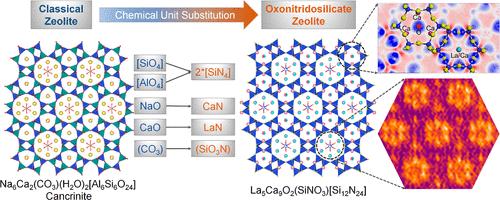Exploring Oxonitridosilicate Synthesis: From Oxide Zeolites to Nitride Frameworks
IF 4.7
2区 化学
Q1 CHEMISTRY, INORGANIC & NUCLEAR
引用次数: 0
Abstract
In this study, we synthesized the first CAN (cancrinite)-typed zeolite-like oxonitridosilicates, Ln5Ca9O2(SiNO3)[Si12N24] (Ln = La and Ce). The crystal structure of La5Ca9O2(SiNO3)[Si12N24] was determined through single-crystal X-ray diffraction (SCXRD) data and neutron powder diffraction (NPD) data refinement. The compound crystallizes in hexagonal space group P63mc (No. 186) with a = 12.9875(2) Å, c = 5.2072(1) Å, and Z = 1. The anionic framework of La5Ca9O2(SiNO3)[Si12N24] is entirely constructed from [SiN4] tetrahedra, forming larger-sized composite building units, t-can and t-ato. The Ca2+ cations in the t-can cage contribute to balancing the charge difference originating from N3– substitution for O2– in La5Ca9O2(SiNO3)[Si12N24], which was revealed by the charge density difference calculation. The Ce3+-doped La5Ca9O2(SiNO3)[Si12N24] shows a broad-band orange-red emission peaking at λ = 630 nm under UV light excitation.

氧化氮硅酸盐合成的探索:从氧化沸石到氮化物骨架
在本研究中,我们合成了第一个CAN (cancriite)型沸石样氧硝基硅酸盐Ln5Ca9O2(SiNO3)[Si12N24] (Ln = La and Ce)。通过单晶x射线衍射(SCXRD)数据和中子粉末衍射(NPD)数据细化,确定了La5Ca9O2(SiNO3)[Si12N24]的晶体结构。化合物在六方空间群P63mc (No. 186)中结晶,a = 12.9875(2) Å, c = 5.2072(1) Å, Z = 1。La5Ca9O2(SiNO3)[Si12N24]的阴离子骨架完全由[SiN4]四面体构成,形成较大尺寸的复合结构单元t-can和t-ato。t-can笼中的Ca2+阳离子有助于平衡La5Ca9O2(SiNO3)[Si12N24]中N3 -取代O2 -引起的电荷差,这是由电荷密度差计算揭示的。在紫外光激发下,Ce3+掺杂的La5Ca9O2(SiNO3)[Si12N24]在λ = 630 nm处显示出宽带的橙红色发射峰。
本文章由计算机程序翻译,如有差异,请以英文原文为准。
求助全文
约1分钟内获得全文
求助全文
来源期刊

Inorganic Chemistry
化学-无机化学与核化学
CiteScore
7.60
自引率
13.00%
发文量
1960
审稿时长
1.9 months
期刊介绍:
Inorganic Chemistry publishes fundamental studies in all phases of inorganic chemistry. Coverage includes experimental and theoretical reports on quantitative studies of structure and thermodynamics, kinetics, mechanisms of inorganic reactions, bioinorganic chemistry, and relevant aspects of organometallic chemistry, solid-state phenomena, and chemical bonding theory. Emphasis is placed on the synthesis, structure, thermodynamics, reactivity, spectroscopy, and bonding properties of significant new and known compounds.
文献相关原料
公司名称
产品信息
阿拉丁
SiO2
阿拉丁
Ca3N2
 求助内容:
求助内容: 应助结果提醒方式:
应助结果提醒方式:


